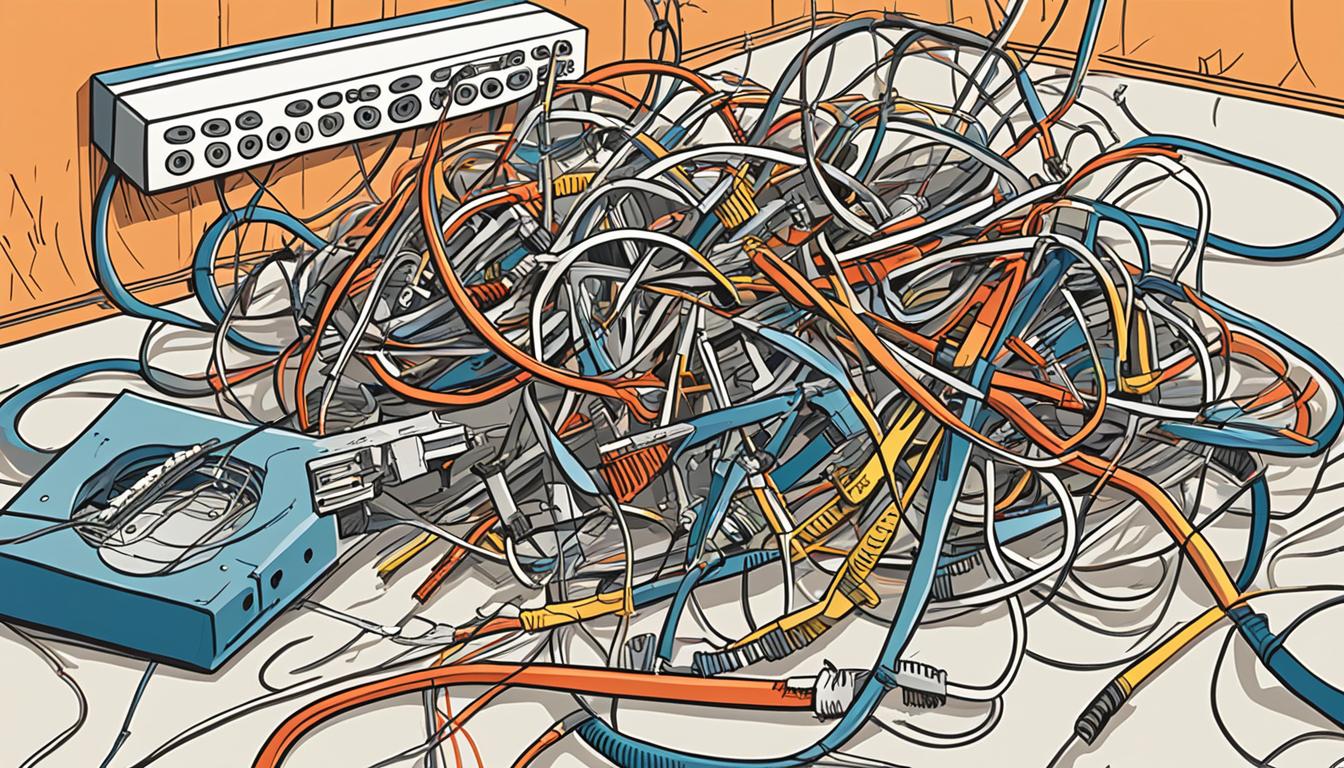Mistakes in your projects can cause delays or even failure. We all know that bad feeling when projects don’t go as planned. Understanding and steering clear of common mistakes helps you achieve success.
Picture this – you’re leading a team on a new software project. Everything starts out well, with everyone excited. Yet, as time goes on, problems arise. Deadlines are missed and the team becomes unhappy. The project edges towards disaster.
The main problem turns out to be unclear goals. The team is not working together because they don’t have a common aim. This confusion makes the project fall apart.
Realizing the mistakes can save the project. You bring your team together to clarify goals. They improve communication and teamwork. With these changes, the project gets back on track.
Key Takeaways:
- Clear project goals keep your team aligned and help track progress.
- Poor communication and teamwork can cause confusion and less work done.
- Lack of planning and documentation can lead to unexpected changes and chaos.
- Not managing risks can bring surprises that cost more money.
- Unrealistic deadlines pressure your team and reduce quality.
Lack of Clear Project Goals
One big mistake in a project is not setting clear goals at the beginning. Without clearly defined objectives, it’s hard to track progress, make good choices, and keep everyone on the same page. Make sure all important people agree on the goals. Always talk about and reassess them during the project.
Unclear or badly shared goals can cause confusion and wasted time. Without a clear plan for success, team members might not know what to do first. This leads to inefficiency and missed chances.
Having clear project goals brings focus and clarity. It outlines the work, sets expectations, and guides the project. Clear goals also help in making good decisions. They give a basis for weighing options and choosing the right way forward.
Key strategies to ensure clear project goals:
- Include key people early on: Get inputs and agreement from important stakeholders when setting goals.
- Define SMART objectives: Goals should be specific, measurable, achievable, relevant, and time-bound. This ensures a clear path to success.
- Communicate often: Keep open lines of communication to inform stakeholders, solve any problems, and remind everyone of the goals.
- Reassess and adjust as needed: Regularly check and update the goals as things change or new info comes up.
“Without clear project goals, it’s like sailing without knowing where to go. You might manage the ship, but you’ll just turn in circles or get lost. Make sure your team knows the destination and its importance.”
Putting clear project goals first sets the stage for success. These goals act like a compass, steering your team towards common results. This enables good decision-making throughout the project.
Poor Communication and Collaboration
In any project, poor communication and collaboration can seriously harm success. If team members don’t talk well or work together, bad outcomes can follow.
Misunderstandings can happen easily without clear and open communication. This might cause mixed-up messages, tasks getting confused, and important info getting lost. Delays, redoing work, and team frustrations are often the result.
Missed deadlines are also a big problem with poor communication and collaboration. Without clear directions and updates, team members might miss or underestimate tasks. This can cause delays that affect the whole project.
“Good communication is the bridge between confusion and clarity.”
Poor communication and collaboration can really slow down productivity. If team members aren’t connected or don’t know what others are doing, progress stalls. It can block the flow of innovative ideas, skills, and resources too.
Project managers need to make sure everyone can talk and work together well. They should start by opening up paths for communication. It’s important for team members to feel safe sharing thoughts, worries, and ideas. Regular team meetings or check-ins are good for sharing and contributing.

Being a good listener is vital for working well together. When team members listen well to each other, they understand and respect feelings and ideas better. This strengthens team bonds and makes a happier, more productive workplace.
It’s also important for project managers to push for teamwork and working across different areas. It brings in a mix of views and better problem-solving. Having team members work together on tasks can break down barriers and bring everyone closer.
“Collaboration is the key to success; it breeds innovation and drives results.”
To make collaboration even better, project managers can use tools that help with sharing info, working on documents together, and communicating in real time. These tools make things smoother, clearer, and keep everyone informed.
By focusing on good communication and teamwork, project managers can avoid problems like misunderstandings, delays, and low productivity. Putting in the effort to build a culture of collaboration lays the foundation for a successful project and stronger teamwork.
Inadequate Planning and Documentation
Lack of planning and documentation can really mess up a project, leading to many issues. These problems include things going beyond what was planned, using resources wrong, and total chaos in the project. To avoid these troubles and make your project run smoothly, give top priority to careful planning and detailed documentation.
Planning is what a project is built on. It involves looking at every part of the project, like what needs to be done, when, and what you want to achieve. Making a detailed plan helps you see problems before they happen and deal with them early. as>
Planning well is like figuring out your route before a trip. as> It lets you find the best way to go, see problems before they arise, and make sure your trip is successful.
Begin by setting clear goals for your project and split them into smaller tasks that you can do. This gives you and your team a clear path to follow. Think about what resources you’ll need, use them wisely, and set realistic timelines for your tasks. By hitting milestones you set, you can keep the project moving smoothly and avoid getting behind schedule. as>
Documentation is super important in managing projects because it keeps a record of everything important. This includes what the project needs, agreements made, choices, and updates on how things are going. Good documentation means everyone knows what’s happening, which cuts down on confusion and wrong ideas. as>
Documentation is like a project’s diary, showing you how things went, what results you got, and what you learned. It makes everything clear, holds people responsible, and is great to look back on for information later. as>
Using project management tools can make documenting things and working together much easier. These tools let you and your team get to project files anytime, talk to each team member easily, and keep project documents up to date and shared. as>
Not planning well or keeping documents can be expensive mistakes and stop your project from doing well. Highlight the need for solid planning, keep documents clear and to the point, and regularly check and update your plans and documents. By doing these things, you’ll make a strong base for your project and raise your chances of getting the results you want. as>

Lack of Risk Management
One huge error in project management is ignoring or neglecting risk management. Not looking into possible risks can really hurt your project’s chances of success. It’s vital to spot potential risks and plan how to handle or avoid them.
Having a good risk management plan lets you see challenges before they happen and lessen their effect. Keep your risk plan updated. This way, you’re always ready for new risks that come up.
“Risk management is key for projects to succeed. Teams can make smart choices and tackle risks well by evaluating and planning for them.”
Begin by finding potential risks that could slow down or hurt your project. These might be anything that affects your goals. Then, figure out how likely each risk is and how bad it could be. This helps you know where to focus your energy.
Come up with strategies to handle or avoid these risks. Include backup plans. This way, you can keep risks from badly affecting your project’s schedule, budget, and results.
It’s not enough to just plan at the start. You need to keep an eye on risks the whole time your project is running. Adjust your plans as needed. This makes sure your team is always ready for surprises.

Importance of Risk Management
Risk management brings big advantages to your project:
- Reduced project disruptions: By getting ahead of risks, you can keep them from messing up your schedule and work.
- Enhanced decision-making: Knowing the risks leads to smarter choices, avoiding expensive errors or delays.
- Improved project outcomes: Managing risks well means happy clients and stakeholders who trust you more.
- Cost savings: Dealing with risks early can stop costly fixes, delays, and going over budget.
Putting time and effort into risk management really pays off. It can make a huge difference in how well your project succeeds.
Scope Creep
When managing a project, keeping control over changes is key to stopping scope creep. Scope creep means unplanned changes that can cause costs to soar, introduce delays, and lower quality. It’s important to have a change control process to examine scope change requests carefully before saying yes.
One good strategy is to write down all scope change requests. This record should explain the change, why it’s needed, and its effect on the project. By writing down every request, you can better understand how the change might affect the project’s schedule, cost, and needed resources.

Evaluating the effect of scope changes is also crucial. This means looking at how changes match the project’s goals, schedule, and resources. By doing this, you can spot potential issues and figure out if adjustments are needed to keep problems away.
Creating a change control board or a similar group is another important step. This board reviews and approves changes based on their impact. Including key people in this process helps make sure changes are fairly reviewed and fit the project’s aims.
| Benefits of Establishing a Change Control Process | Consequences of Scope Creep |
|---|---|
|
|
Evaluating Scope Changes
Consider the following when looking at scope changes:
- How it affects project goals: Check if the change fits the project’s main aims. Think about the pros and cons.
- The project schedule: See if the project has room for this change. Look out for any possible delays it might cause.
- What resources are available: Make sure the project has what it needs to handle the change. Decide if you need more resources or adjustments.
- Risks that could come up: Identify any risks the change might bring. Think about how it could affect quality, budget, and happiness of stakeholders. Plan ways to lessen these risks.
Scope creep can really mess up a project by adding unnecessary complications. Having a clear change control process is key to managing scope changes and keeping the project on track.
Unrealistic Timeframes and Deadlines
Setting deadlines that are too tight can hurt a project. It’s key to balance urgency with the project’s complexity. It’s also vital to think about potential problems ahead of time.
Pushing your team too hard can lead to stress and burnout. This stress can lower the quality of work. This can then affect the project’s success.
To avoid these issues, really look into the project details. Think about how many tasks there are, resources available, and possible obstacles. This approach is crucial for success.
Understand the project fully to set realistic timelines. This involves accounting for unexpected issues. It leads to reachable goals and avoids missed deadlines.
Aiming for both efficiency and quality is important in project management. It’s sometimes better to have a longer timeline than to hurry and make mistakes. Talk with your team to set realistic timelines.
“The key is not to prioritize what’s on your schedule, but to schedule your priorities.” ― Stephen R. Covey
With realistic deadlines, the work environment improves, supporting productivity and high-quality results. Reflect on the project needs and set goals that your team can actually achieve. This way, your team is set up for success.
Have a look at the table below to understand the impact of unrealistic timeframes and deadlines:
| Effects of Unrealistic Timeframes and Deadlines | Potential Consequences |
|---|---|
| Inadequate planning and preparation | Increased risk of errors and oversights |
| Unrealistic workloads | Team stress and burnout |
| Poor quality deliverables | Decreased customer satisfaction |
| Missed deadlines | Reputation damage and loss of trust |
| Increased project costs | Financial strain on the organization |
Unrealistic deadlines can negatively affect many aspects of your project. Setting realistic goals and valuing quality over speed is important. This way, your team can do well.
Good project management finds the right balance between doing things fast and doing things well. By choosing realistic deadlines, projects will run smoothly and get great results.tuned!
Poor Resource Management
Inefficient resource management can greatly harm a project. It can cause delays, higher costs, and less productivity. To get better at managing resources, here are some important tips:
1. Understand your resource needs
First, figure out what your project needs. Know which people, tools, and materials are essential. Understand how much and what kind of each you need. This makes planning and resource sharing better.
2. Allocate resources accordingly
After figuring out what you need, share resources the right way. Match tasks with people who have the right skills. Make sure they have what they need to do the job. Think about their workload and if they’re the best fit for the task.
3. Regularly monitor resource utilization
Watch how you’re using resources throughout the project. Keep an eye on resource use and fix any problems quickly. Adjust how you’re sharing resources as the project goes on.
“Efficient resource management is a key driver of project success. It allows you to utilize your available resources effectively, minimize waste, and ensure that tasks are completed on time and within budget.”
4. Optimize efficiency
Always look for ways to use resources better and improve work. Find ways to make processes simpler and automate them if you can. Keep in touch with your team to make sure they have what they need.
5. Seek feedback and improvement
Let your team share ideas and thoughts about managing resources. Really listen to what they say and use their advice. Learn from every project to avoid making the same mistakes.
Following these steps will help you avoid poor resource management. This will make your projects run smoother and be more successful.
| Common Resource Management Mistakes | Effective Resource Management Strategies |
|---|---|
| Inadequate allocation of personnel | Thoroughly assess resource needs and assign personnel with the right skills and availability. |
| Lack of visibility into resource utilization | Regularly monitor and evaluate resource utilization to identify bottlenecks and inefficiencies. |
| Poor coordination of tools and materials | Ensure that the necessary tools and materials are available and accessible to the team members who need them. |
| Failure to adapt resource allocation as project needs change | Continuously reassess and adjust resource allocation based on evolving project requirements and priorities. |
| Lack of communication and collaboration | Facilitate clear communication and collaboration between team members to optimize resource utilization. |

Efficient resource management is key to a successful project. By smartly allocating tools, people, and materials, you can dodge the common traps. Regularly check how resources are used and always look for ways to get better.
Lack of Stakeholder Engagement
Not involving key stakeholders in a project can lead to big problems. Without their input, a project may fail. It’s important to bring stakeholders into the project early. This way, everyone’s on the same page.
Keeping stakeholders updated and listening to their feedback is key. They feel part of the team and are more likely to help. Involving them makes sure the project meets their needs. This brings us closer to our goals.
Understanding stakeholders’ needs and how they impact the project is critical. Communicate in ways they prefer—meetings, emails, or online platforms. This helps build a strong partnership. It keeps the project moving smoothly.
“Effective stakeholder engagement is crucial for project success. By actively involving stakeholders throughout the project, you create a shared sense of purpose and accountability, resulting in improved alignment, support, and ultimately, successful outcomes.”
Benefits of Stakeholder Engagement
Getting stakeholders involved early brings many benefits:
- Improved project understanding and decision-making through diverse perspectives
- Enhanced project alignment with stakeholder needs and expectations
- Increased stakeholder support, minimizing resistance and obstacles
- Open channels for feedback and concerns, leading to quick resolutions
- Timely identification of risks and opportunities for continuous improvement
Stakeholder engagement needs to be an ongoing effort. Keep them in the loop with regular updates and chances for input. This keeps them interested and active in the project. It lays the groundwork for success through collaboration and innovation.

Poor Quality Control
Poor quality control can really hurt a project’s success and its reputation. If quality control is ignored, the project’s results may not meet expectations. This can lead to redoing work, unhappy customers, and harm to your brand. To make sure your project succeeds, it’s key to have a strong quality control process in place.
A robust quality control process includes important steps, such as:
- Regular inspections. Inspecting work at different stages lets you find and fix quality issues early. This keeps the project on the right path for quality.
- Testing. Testing is vital to quality control. It checks if project results work right and meet all requirements. This step makes sure there are no bugs, errors, or problems.
- Feedback loops. Setting up feedback loops lets your project improve continuously. Getting input from everyone involved gives insights for bettering the project. This way, your project’s quality keeps getting better.
By following these steps, you can meet and even surpass the quality expected. Doing so prevents problems, increases client happiness, reduces redoing work, and protects your company’s image.
Real-Life Example:
“Quality is not an act, it’s a habit.” – Aristotle
This saying from Aristotle may not be about project management, but it shows how key quality is. Making quality a regular part of your project can lead to excellent results.

| Effects of Poor Quality Control | Benefits of Robust Quality Control |
|---|---|
|
|
Lack of Accountability and Leadership
Projects can stray without clear accountability and strong leadership. It’s essential to give team members specific roles. They should know what they are responsible for. This approach avoids confusion, inefficiency, and disorganization within the project.
Leadership is key to guiding teams towards success. Good leaders motivate their team, setting an example. They make everyone want to work together and do their best. It’s about guidance, realistic expectations, and a positive work environment. This empowers teams to excel.
Effective leaders provide the support their teams need to succeed. They are approachable, ready to address concerns and offer guidance. Such support builds trust and makes everyone feel responsible and accountable for their work.
A focus on team growth is what makes a good leader stand out. They promote learning and professional development, inspiring their teams. This pushes the team to go above and beyond, achieving remarkable things.
“The function of leadership is to produce more leaders, not more followers.” – Ralph Nader
Benefits of Accountability and Leadership:
- Increased productivity and efficiency
- Enhanced team collaboration and synergy
- Improved decision-making and problem-solving
- Consistent achievement of project milestones and goals
- Boosted morale and motivation among team members
Example of Accountability and Leadership in Action:
| Project Role | Responsibilities | Accountability |
|---|---|---|
| Project Manager | Define project objectives, set timelines, allocate resources | Ensure project milestones are met, manage project risks and issues |
| Team Leader | Delegate tasks, provide guidance and support to team members | Ensure quality deliverables, monitor team performance and progress |
| Team Member | Complete assigned tasks, collaborate with team members | Meet deadlines, contribute to team goals, communicate progress |
| Stakeholders | Provide input and feedback, support decision-making | Review project deliverables, ensure alignment with expectations |
By building accountability and strong leadership, you create a project environment filled with trust and high performance. Accountability begins with clear expectations. And leadership shines through effective communication and support.

Insufficient Risk Assessment
Not doing a full risk check can hurt your project badly. If you don’t spot and size up possible dangers, you’re open to surprises and higher costs. It’s key to put risk checking first and make good backup plans.
Start by spotting what could go wrong with your project. Look at threats or unknowns, both inside and outside. Figure out how big each risk could be and its chance of happening. This helps you know which risks matter most and where to use your resources.
After finding risks, make plans to lessen their impact. Your plans should clearly say what steps and tactics to use for each risk. Put in actions to lower the chance of risks happening. Also, be ready to act fast if any risk does happen.
Risk checking should keep going as your project moves ahead. Keep looking at and updating your risk check to stay ahead of possible dangers. This keeps you ready for changes and helps your project stay on path, even when unexpected things happen.

Putting risk assessment first and having strong risk plans can cut down dangers to your project. Be proactive to keep your project safe, in control, and on the way to success.
Poor Change Management
Change is a sure thing in any project. Projects evolve with new needs, altered deadlines, or different priorities. These shifts can greatly affect the outcome. But, handling change badly can cause problems. It leads to pushback, confusion, and delays.
To deal with change well, having a good management plan is vital. This should have clear talks, engaging people involved, and a method to check and apply changes. Doing this helps manage change smoothly and reduce its effect on the project.
Good communication is crucial for managing change. Make sure everyone knows why things are changing, what the effects might be, and how it fits with the project’s goals. It’s important to talk openly. Address any worries or questions people have.
It’s also important to involve stakeholders in the change process. Get them on board early on. This way, you can address their concerns and get their ideas. Working together like this creates a feeling of ownership. It also makes sure changes have a positive effect.
A methodical way to look at and apply changes adds order. Assess each change for its pros and cons. Consider if it’s workable, and understand how it affects the project’s schedule, resources, and budget. This avoids sudden changes that can mess up the project and cost extra money.
Poor management of change can really set a project back. Build a change management plan that focuses on clear talks, engaging stakeholders, and a structured way to handle changes. This lets you manage change well and keep your project moving forward.
Lack of Flexibility and Adaptability
In today’s fast-moving business world, projects often hit unexpected problems. Not being flexible or adaptable can harm your project’s chances of success. If you can’t respond well to changes, overcoming sudden hurdles becomes harder.
To become more flexible and adaptable, it’s important to embrace agile methods and inspire creativity in your team. Being open to adjusting your plans helps tackle unexpected issues quickly. This way, you stay ahead and react swiftly to shifts in the business world.
Building a team culture that values adaptability leads to creative thinking and effective problem-solving. It allows your team to think differently, find new solutions, and adapt to changes. By valuing adaptability, you grab new opportunities and keep your project moving forward, no matter what.
Remember, being flexible and adaptable shows strength, not weakness. These qualities help you deal with the constantly changing business environment. They improve your project’s chance for success and prepare your team to face any challenges.
Flexibility is not just about bending without breaking. It’s about embracing change with an open mind and a willingness to explore new possibilities.
– Richard Branson
Importance of Flexibility and Adaptability in Project Management
Flexibility and adaptability are key in project management. They help you:
- Respond effectively to changes in project requirements or external factors.
- Identify and capitalize on new opportunities as they arise.
- Address unexpected challenges and hurdles with agility.
- Keep your project on track despite evolving circumstances.
- Maximize your team’s creativity and problem-solving capabilities.
Putting flexibility and adaptability first in project management builds a strong and capable team. It prepares them to handle any situation, setting the stage for success in a changing business world.
Benefits of Flexibility and Adaptability in Project Management
| Benefit | Description |
|---|---|
| Effective Change Management | Flexibility allows for smoother integration of changes, reducing resistance and improving project outcomes. |
| Increased Problem-Solving Abilities | Adaptability fosters a mindset that encourages innovative thinking and creative problem-solving. |
| Optimized Resource Allocation | Flexibility enables you to adjust resource allocation based on changing project needs, improving efficiency. |
| Enhanced Stakeholder Engagement | Adaptability ensures that you can meet stakeholder expectations and address their evolving needs throughout the project lifecycle. |
| Proactive Risk Mitigation | Flexibility allows you to anticipate and address potential risks and uncertainties, minimizing their impact on project success. |
By embracing flexibility and adaptability, your project management approach becomes better suited to face today’s challenges and uncertainties.

Conclusion
Avoiding big mistakes in your projects is key to success. By using the tips in this article, you can avoid common errors. Clear goals, better communication, and managing risks help a lot.
Planning carefully, talking openly, and solving problems early are important. Start with clear goals, work together, and check for risks regularly. This helps dodge common mistakes that teams often make.
Learning from others and using proven methods are good steps. This way, your projects will run smoothly and meet their goals. So, remember these tips, use them well, and enjoy success in your projects!










